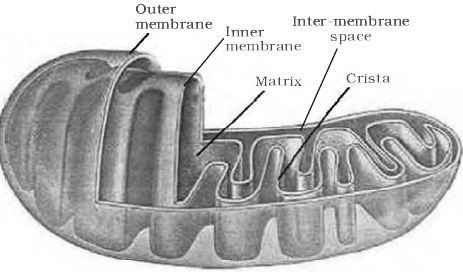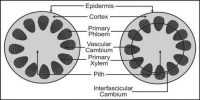Mitochondria (sing.: mitochondrion), unless specifically stained, are not easily visible under the microscope. The number of mitochondria per cell is variable depending on the physiological activity of the cells. In terms of shape and size also, considerable degree of variability is observed. Typically it is sausage shaped or cylindrical having a diameter of 0.2 – 1.0 μm (average 0.5 μm) and length 1.0 – 4.1 μm.
Each mitochondrion is a double membrane bound structure with the outer membrane and the inner membrane dividing its lumen distinctly into two aqueous compartments, i.e., the outer compartment and the inner compartment.

Figure: Structure of mitochondrion (Longitudinal section)
The inner compartment is called the matrix. The outer membrane forms the continuous limiting boundary of the organelle. The inner membrane forms a number of infoldings called the cristae (sing.: crista) towards the matrix (Figure). The cristae increase the surface area. The two membranes have their own specific enzymes associated with the mitochondria] function. Mitochondria are the sites of aerobic respiration. They produce cellular energy in the form of ATP, hence they are called ‘power houses’ of the cell. The matrix also possesses single circular DNA molecule, a few RNA molecules. ribosomes (70S) and the components required for the synthesis of proteins. The mitochondria divide by fission.











